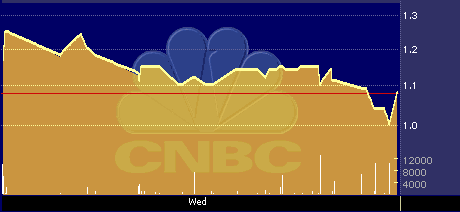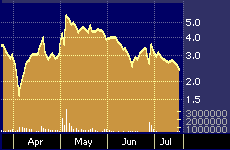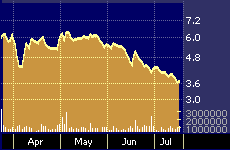
Caldera Systems IPO Soars in Debut
Caldera Systems IPO Soars in Debut
By Hal Plotkin
Silicon Valley Correspondent
Caldera Systems Inc.’s {CALD} initial public offering is already being boosted in its debut by the same Linux fever that propelled the recent Red Hat Inc. {RHAT} and VA Linux Systems Inc. {LNUX} IPOs to soaring opening-day performances.
The stock opened at $26, after pricing its 5 million share offering late Monday at $14, above its price talk of $10 to $12. The company’s original price range was $7 to $9.

Post-IPO performance chart for CALD
“The market has demonstrated that it still has a thirst for Linux IPOs,” says Stacey Quandt, an analyst at Giga Information Group, based in San Jose, Calif.
Orem, Utah-based Caldera Systems is widely regarded as one of the top four Linux companies, along with Durham, N.C.-based Red Hat; VA Linux Systems, based in Sunnyvale, California; and SuSE GmbH, based in Germany. Canada’s Corel Corp. {CORL}, which recently introduced its own version of the Linux operating system and which offers several applications that run on the Linux OS, is also fast becoming a major Linux player.
All told, there are now more than 145 companies distributing versions of the free Linux operating system, according to International Data Corp., based in Framingham, Mass.
“There’s no doubt Caldera is bunched up near the top of that pack,” says Philip Rueppel, an analyst with Deutsche Banc Alex. Brown, based in San Francisco. “The company certainly is perceived very highly.”
As such, Caldera could well be the next beneficiary of the investor enthusiasm that greeted previous Linux-related IPOs. Red Hat, for example, went public last Aug. 10, with shares initially priced at $14, while VA Linux Systems, which posted one of the biggest first-day trading gains ever, went public on Dec. 8, with shares initially priced at $30.

Post-IPO chart for LNUX

Post IPO chart for RHAT
“Linux is the operating system of choice in the Internet world,” says Walter Winnitzki, an analyst at Chase H&Q, based in San Francisco, California. “A lot of that has to do with scalability and reliability. You have a whole global community of Linux developers that are working on making it work and improving it.”
Unlike proprietary operating systems sold by companies such as Microsoft Corp. {MSFT} and Sun Microsystems Inc. {SUNW}, the vendors of open-source Linux make the source code of their products freely available. Armed with the source code, programmers can modify or improve the software without needing the help or permission of the original manufacturer.
“Everyone who uses open-source software can benefit whenever the software is improved,” Quandt says.
Rather than make money selling software or software-user licenses, open-source companies generate most of their revenue by selling documentation and related professional services that help businesses use Linux to maintain and improve their operations.
At present, Linux is finding its widest acceptance powering Web servers, the powerful computers that pump information on to the Internet. Analysts see several other growing markets for Linux in the future, including so-called thin-appliance servers used to deliver software applications over the Internet, along with a wide variety of other devices, ranging from set-top boxes to personal digital assistants.
The worldwide market for thin-appliance servers is projected to grow to $16 billion by 2003 from $2.2 billion last year, according to Dataquest, based in San Jose, Calif. Overall, the total market for Linux shipments is projected to grow at a 25 percent compound annual rate between now and 2003, according to IDC.
Analysts say Caldera Systems is well positioned to benefit from that projected growth due, in part, to its close relationship with Sun Microsystems, a leading vendor of server hardware. Sun has its own Web server operating system, called Solaris, that competes with both Microsoft’s Windows NT and Linux.
Sun recently took an equity position in Caldera, joining with Citrix Systems Inc. and several other firms that banded together to make a $30 million pre-IPO investment in the company.
“Sun’s role is the most intriguing for investors,” Quandt says. “Sun could potentially shift the market in Caldera’s favor if it starts installing its Linux software on its hardware.” That development would also give Caldera access to Sun’s enormous base of installed users.
Dan Kuznetsky, program director at IDC, agrees that Caldera is one of the top Linux distributors but says the company hasn’t done as good a job building brand awareness as competitors Red Hat and VA Linux Systems did prior to their IPOs.
“They have a wonderful demo, and the product looks very good,” Kuznetsky says. “But if you asked people on the street about Caldera they would probably think you are talking about a volcano in Hawaii.”
Kuznetsky says Caldera’s relative anonymity could hurt the company. “I think it is going to be a challenge for them,” he says. Compared with Red Hat and VA Linux, “I just don’t sense as much of a buzz about the company. At this point, most people outside of the Linux community are not aware of it. That said, what they are offering is a solid product.”
It is also a very well-reviewed product within the Linux community. Caldera Systems’s version of Linux, for example, makes the formerly cumbersome process of installing Linux considerably easier. Users can, for example, play a computer game called Tetris while the software automatically installs itself.
“Even the experts appreciate that,” Rueppel says. “If you can save 10 minutes every time you load it on a system, that’s a very valuable feature.”
The product’s user-friendly features have won the company several recent awards, including the 1999 product of the year nod from the Linux Journal, a trade publication.
Despite general optimism regarding the Linux OS, most analysts warn, however, that the business case for Linux companies has yet to be fully established. There are concerns, for example, that both Red Hat and Caldera Systems may eventually suffer in the marketplace because they are too closely tied to their own distributions, or versions, of the Linux OS.
Other companies, such as CollabNet Inc., a privately held firm based in San Francisco, use whatever Linux distributions are best-suited to serve the customers for whom they customize products, a key revenue stream targeted by all the Linux companies.
“The single-distribution vendors could be at a disadvantage in the future,” Quandt says.
What’s more, rival Red Hat has already scooped up many of the key software developers who work on improving the heart of the Linux OS, which is called the kernal. Caldera, by contrast, has fewer programmers employed who are publicly associated with the continual improvement of the software.
“That could give an advantage to Red Hat down the line,” Quandt says. “They could take Linux in a direction that might leave Caldera having to play catch-up.”
In the meantime, given the reaction to previous Linux-related IPOs, it seems likely that investors will find the pending Caldera Systems IPO attractive, perhaps even irresistible.
“Right now, we’re seeing enormous growth in [Linux] shipments and modest growth in revenues,” Kuznetsky says. “In the future, though, free software could drive the need for all of the other related ancillary business services.”
Caldera Systems posted a loss of $9.3 million on revenue of $3.05 million in fiscal 1999, as compared with a loss of $7.9 million on revenue of $1.05 million during the previous year.


